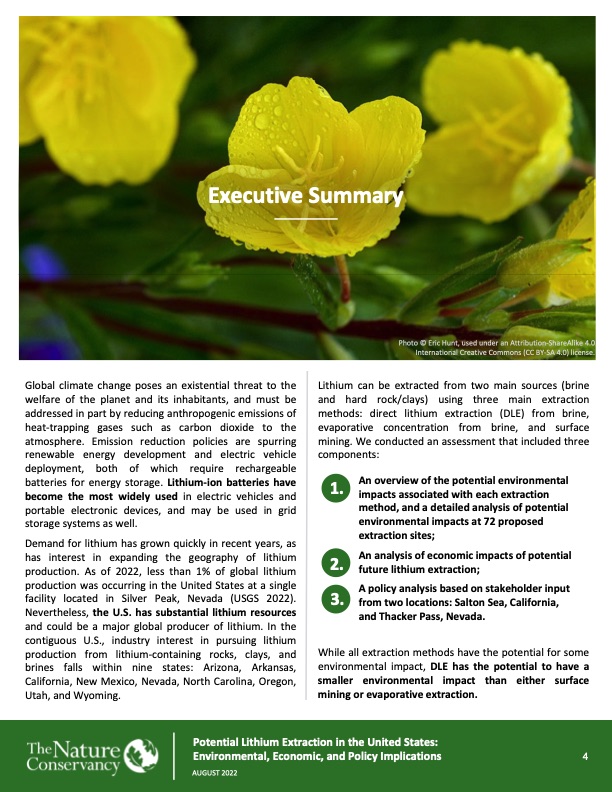
PDF Publication Title:
Text from PDF Page: 004
Executive Summary Global climate change poses an existential threat to the welfare of the planet and its inhabitants, and must be addressed in part by reducing anthropogenic emissions of heat-trapping gases such as carbon dioxide to the atmosphere. Emission reduction policies are spurring renewable energy development and electric vehicle deployment, both of which require rechargeable batteries for energy storage. Lithium-ion batteries have become the most widely used in electric vehicles and portable electronic devices, and may be used in grid storage systems as well. Demand for lithium has grown quickly in recent years, as has interest in expanding the geography of lithium production. As of 2022, less than 1% of global lithium production was occurring in the United States at a single facility located in Silver Peak, Nevada (USGS 2022). Nevertheless, the U.S. has substantial lithium resources and could be a major global producer of lithium. In the contiguous U.S., industry interest in pursuing lithium production from lithium-containing rocks, clays, and brines falls within nine states: Arizona, Arkansas, California, New Mexico, Nevada, North Carolina, Oregon, Utah, and Wyoming. Photo © Eric Hunt, used under an Attribution-ShareAlike 4.0 International Creative Commons (CC BY-SA 4.0) license. Lithium can be extracted from two main sources (brine and hard rock/clays) using three main extraction methods: direct lithium extraction (DLE) from brine, evaporative concentration from brine, and surface mining. We conducted an assessment that included three components: 1. An overview of the potential environmental impacts associated with each extraction method, and a detailed analysis of potential environmental impacts at 72 proposed extraction sites; An analysis of economic impacts of potential future lithium extraction; 2. 3. from two locations: Salton Sea, California, A policy analysis based on stakeholder input and Thacker Pass, Nevada. While all extraction methods have the potential for some environmental impact, DLE has the potential to have a smaller environmental impact than either surface mining or evaporative extraction. Potential Lithium Extraction in the United States: Environmental, Economic, and Policy Implications 4 AUGUST 2022PDF Image | Potential Lithium Extraction in the United States

PDF Search Title:
Potential Lithium Extraction in the United StatesOriginal File Name Searched:
Lithium_Report_FINAL.pdfDIY PDF Search: Google It | Yahoo | Bing
Product and Development Focus for Infinity Turbine
ORC Waste Heat Turbine and ORC System Build Plans: All turbine plans are $10,000 each. This allows you to build a system and then consider licensing for production after you have completed and tested a unit.Redox Flow Battery Technology: With the advent of the new USA tax credits for producing and selling batteries ($35/kW) we are focussing on a simple flow battery using shipping containers as the modular electrolyte storage units with tax credits up to $140,000 per system. Our main focus is on the salt battery. This battery can be used for both thermal and electrical storage applications. We call it the Cogeneration Battery or Cogen Battery. One project is converting salt (brine) based water conditioners to simultaneously produce power. In addition, there are many opportunities to extract Lithium from brine (salt lakes, groundwater, and producer water).Salt water or brine are huge sources for lithium. Most of the worlds lithium is acquired from a brine source. It's even in seawater in a low concentration. Brine is also a byproduct of huge powerplants, which can now use that as an electrolyte and a huge flow battery (which allows storage at the source).We welcome any business and equipment inquiries, as well as licensing our turbines for manufacturing.| CONTACT TEL: 608-238-6001 Email: greg@infinityturbine.com | RSS | AMP |